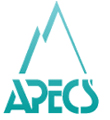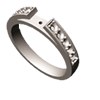|
IN THE FORTIETH YEAR of Apecs Investment Castings, the Australia Day Honours List included Tony Eccles as an Officer in the Order of Australia.
The honour presented by the Governor of Queensland in April was awarded "for services to the jewellery craft, particularly through the development of innovative and ground-breaking techniques, to technical education through the promotion of traineeship programs in Australia and overseas, and to the community as a supporter of at-risk youth by encouraging participation in programs."
If brevity had been a requirement, Tony easily could have been honoured simply for making good use of an inquiring mind and a generous spirit. He has solved two problems which bedevilled the worldwide jewellery trade for centuries.
A Better Kind Of 9 Carat
In the early days of Apecs, Tony made his own alloys[1] in order to secure a better profit margin. Like others throughout the jewellery trade at that time, he was bothered by the problems stemming from porosity in cast 9 carat gold jewellery. In 1965, his 'tinkering' with alloy ingredients led him to believe that by introducing silicon to the traditional alloy, he could effectively reduce the porosity to produce stronger 9 carat.
Wanting to learn more in an environment where casters jealously guarded trade secrets and little information was available in written form, Tony took himself to London. There, he suggested his silicon idea to Peter Gainsbury, technical director and metallurgist with the Worshipful Company of Goldsmiths. Tony gave Peter his alloy formula, and Peter eventually passed the formula[2] to UK refining and casting firms Engelhard and Mattheys. The Company of Goldsmiths of the time was reluctant to give credit to outsiders, but in due course, the refining community came to realise that 'silcalloy' was Tony's discovery. Tony had produced excellent castings with the use of 'silcalloy' before going to the UK, and the process helped his business to grow and prosper.
Among The Seekers
Tony was not the only worker in precious metal who regretted the scarcity of information-sharing within the craft. For the past seventeen years, an assembly of like-minded artisans and metallurgists has been seeking to rectify the dearth of technical data. Tony was there at the second gathering of the famous Santa Fe Symposium[3] in New Mexico, USA. All up, he now has attended nine times and presented three papers which share his knowledge with an international audience. He has seen the symposium outgrow Santa Fe and move to Albuquerque, although retaining its original name.
Out, Damned Smudge
It was at one such gathering that Tony was approached by Mel Bernhard of the US firm, United Precious Metal Refining. Mel gave Tony a bearhug and profound thanks for the discovery of 'silcalloy' an advance which he believed had aided the success of UPMR. In gratitude, Mel gave Tony a formula for a silver alloy which also incorporated silicon. Mel confessed that the finished alloy was too soft for jewellery-making, and he hoped that Tony might be able to improve it.
Wherever silver was cast as jewellery or ornaments, smiths faced a common problem when it came time to polish the finished article. The surface of the piece would be marred by firescaling oxides occurring on the surface of some metals when they are brought to a high temperature. The real, and maddening, problem was that when the artisan had polished away the black or coppery smudge, the blemish would soon return.
Tony did not have an immediate solution to the universal problem, but further research stemming from an earlier Santa Fe Symposium led Tony to try adding germanium to a silver silicon alloy. It might have seemed an improbable choice to the uninformed. Germanium is a brittle, greyish-white, semi-metallic element which would seem to have little in common with gleaming silver. After much experimentation, Tony produced the hard, bright, silver alloy discovered in 1994 and patented in many countries as Bright Silver. In the USA, Tony's old friend Mel Bernard produces Bright Silver[4] under licence.
Making Light Work Of Metal
Tony's quest for better ways to work with precious metals is far from finished. Techniques which have him captivated now are hydraulic die-forming and CAD-CAM. Both make lighter, faster work for those who fashion beautiful things from metal.
At yet another Santa Fe Symposium, Tony was introduced to the hydraulic die-forming process developed by Lee Marshall of Bonny Doon Engineering in California. Based on the concept of a portable hydraulic press, this method of forming removes a hard and monotonous task from both the one-off and the series production work of jewellers and smiths who are making items ranging from objects d'art to bracelets to metal bowls. The process lends itself to both precious and non-precious metals and a range of activities including blanking, stamping, repousse', chenier and more.
Tony was so impressed, and so intent on sharing the new expertise, that he obtained the Australian agency for the specialised equipment and encouraged Lee to conduct a seminar in Australia. Following that first workshop in October last year, another was held this May at the Apecs premises in Burwood, VI C. Hands-on training for ten members of the trade included three-dimensional metal forming, acrylic and metal die-making, 'sawless' metal cutting, sheet metal embossing and folding, and raising a bracelet.
In skilled hands, CAD-CAM, Computer Aided Design and Computer Aided Manufacturing, can seem like a magic wand for those who design and manufacture jewellery. The advantages are speed, precision, and the ability to produce many variations from a single design. Flexibility and digital accuracy give designers more opportunity to explore possibilities . . . more quickly.
And family is exactly what Apecs is . . . twenty employees involved by birth or marriage or simple commitment to excellence in what they do.
Christine, Tony and Ann’s eldest daughter, is a qualified jeweller with 12 years at Apecs in customer liaison and collaboration with Tony on the Apecs catalogue. Son-in-law Gary Lunt has been the company's technical manager for 27 years. Ann Eccles retired six years ago after long years as motherly mainstay of both the family and the business.
Accountant Dimi Kafkas has 18 years with Apecs. Orders department supervisor Ronnie Collins has 25. It is this kind of company-wide continuity which makes customer service a serious selling point for Apecs.
|
|
The APECS Difference
In addition to that family feeling and an appetite for improvement, Apecs makes a point of customer service in all its forms. A daily pick-up and delivery service is available in the Melbourne CBD. Nationally, customers benefit from personal visits by Apecs management, and of course, modern communications make light of distance. The main customer base today for Apecs is artisans, small-to-medium retailers, and manufacturer-wholesalers. They all appreciate close contact with their casting house.
Near and far, Apecs customers benefit from an annual catalogue[5]. Twenty-one years ago, the Apecs catalogue was the first to be produced by an Australian casting house. Every year since then, the choice of product has increased. Now there are 4,000 available designs, plus about 1,000 charms. The range includes earrings, rings, lockets, tennis bracelets, Australiana brooches and 100gm silver Australiana fauna pieces. The earlier pages in the catalogue are in black and white, but newer additions are all in colour.
Another Apecs catalogue innovation is to show jewellery settings with samples of the gemstones they will ultimately hold, so that customers can visualise how the finished product will look. The catalogue assists further by indicating the size of gem needed for the setting. As well as the printed version the Apecs catalogue is also available on CD which also includes information on solders and temperature conversion charts, stock finger size information, an order form and 'The Process' video.
For the past ten years, Apecs has offered customers their choice of semi-finished castings or fully finished jewellery. By supplying the finished article, Apecs adds value to its sales while freeing retail jewellers to concentrate on what they do best.
Apecs has been offering platinum casting since 1995, when the company imported a top-quality German machine for the purpose. At first, there was only enough interest in platinum to operate the machine once every three weeks. Today, the market's appetite for platinum is sufficient to require casting several times a week.
Life Lessons
The Apecs story had its real beginning when a young apprentice jeweller found that he could not get on with his master. Eventually, Tony simply quit. He knew he had potential, but the experience left low on confidence and out of work. One day in this somewhat bleak period, Tony's father announced that a jeweller had phoned and wanted to see Tony. The young man rushed off to his 'appointment', only to find that the jeweller knew nothing about either the appointment or any vacancy. However, the jeweller was so impressed with Tony's initiative that he gave him a job on the spot. Tony remembers the experience as a very good lesson in making one's own opportunity.
Eventually, Tony became one of three partners in the Melbourne firm, Marcus Jewellers. It was there that he became fascinated with the ancient art of casting . . . and was suddenly left a widower with four children. He decided to concentrate on casting as a business, although at this time, he had no experience in gold casting. He offered his two partners at Marcus the choice of selling their shares in the business or buying him out. They made the latter choice. Meanwhile, Tony had met and married Ann, who gave up her nursing career in order to care for the ready-made family and support her husband in his new business. He called the new company Apecs, the Anthony Philip Eccles Casting Service. The sale of Tony's share in Marcus Jewellers provided just 3,000 pounds for their first year together -1,000 for a second-hand casting machine, 1,000 for business overheads and 1,000 for living expenses. That was 1963, and Tony was just out of his twenties.
"For two years, I worked twelve to sixteen hours a day," Tony said.
Ann took Baby Andrew with her as she did pick-ups and deliveries for the fledgling business at Canterbury, VIC. In 1982, Tony and Ann moved to Caloundra, QLD and devoted themselves to national and international sales for Apecs.
In 1987, the Apecs facility was moved to the current purpose-built factory in the Melbourne suburb of Burwood.
More recently, Tony and Ann moved to Beerwah, about twenty minutes from Caloundra. The area is famous for the Glasshouse Mountains, named by Captain Cook for the way they looked from the coast. If Beerwah seems a vaguely familiar name, it's probably because it also is the location of the Australian zoo made famous by Steve Irwin, the Crocodile Man.
The Aim, Not The Claim
No one at Apecs, and Tony Eccles least of all, is in the habit of standing still to indulge in self-congratulation. The Apecs motto is 'The Peak of Perfection'. The suggestion is that perfection is the goal, and the company's four decades of innovation are an upward climb towards that peak.
"Success is a journey, not a destination," Tony said, "and Apecs is only forty years into its journey."
[1] All alloys with the exception of platinum hard cast are alloyed and assayed in house for optimum control and assurance of alloy quality.
[2] The 'Silcalloy' alloy formula can be found at - http://www.apecs.com.au/evolutionofall/page6.htm
[3] Information on the Santa Fe Symposium years can be found at - http://www.santafesymposium.org/
[4] Further information on 'Bright Silver' can be found at - http://www.apecs.com.au/bright.htm
[5] Catalogue information can be found at - http://www.apecs.com.au/products.htm
Text reproduced from the article in "Jewellery World" July 2003.
|













